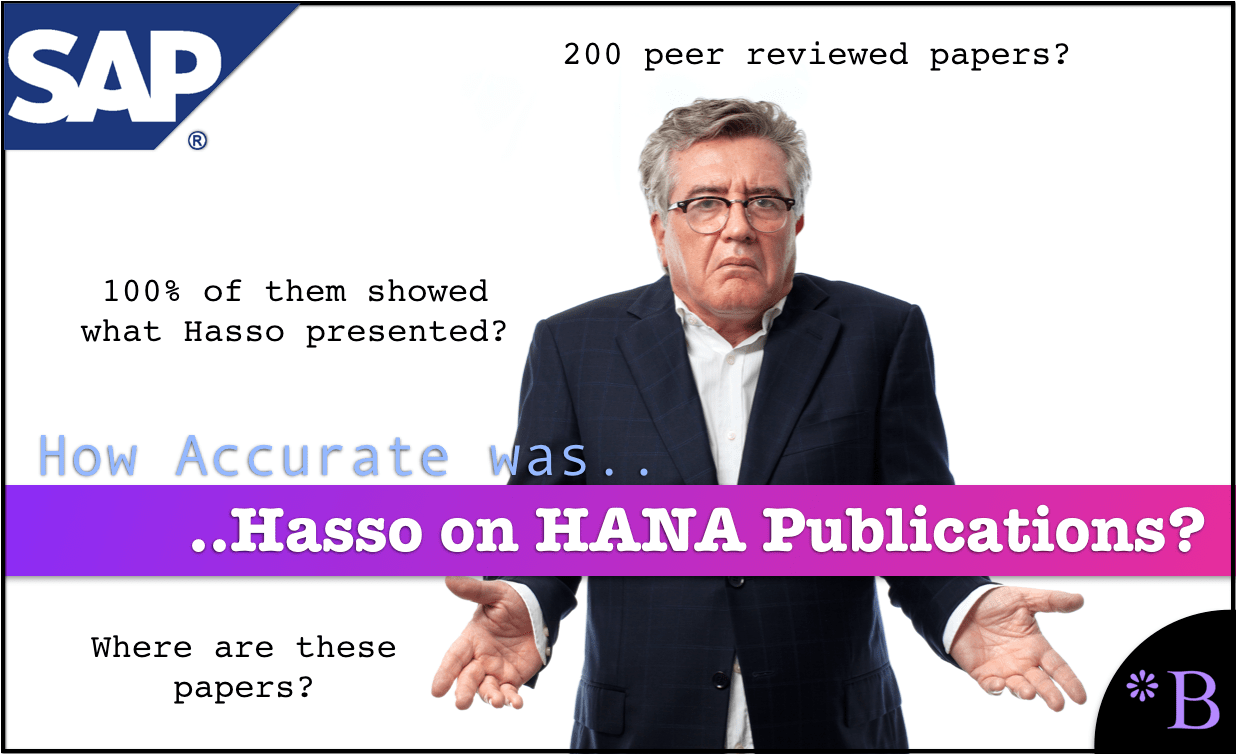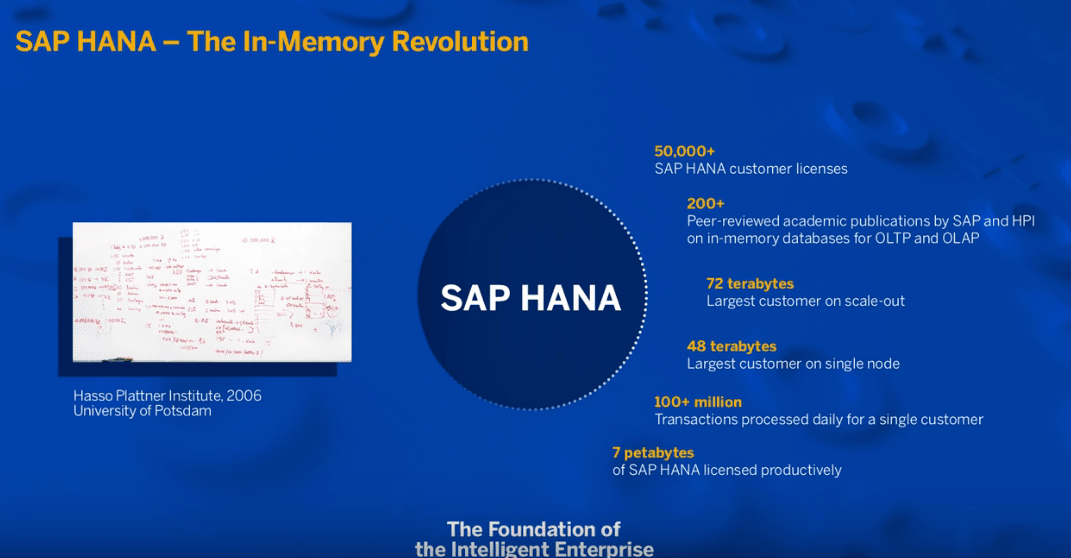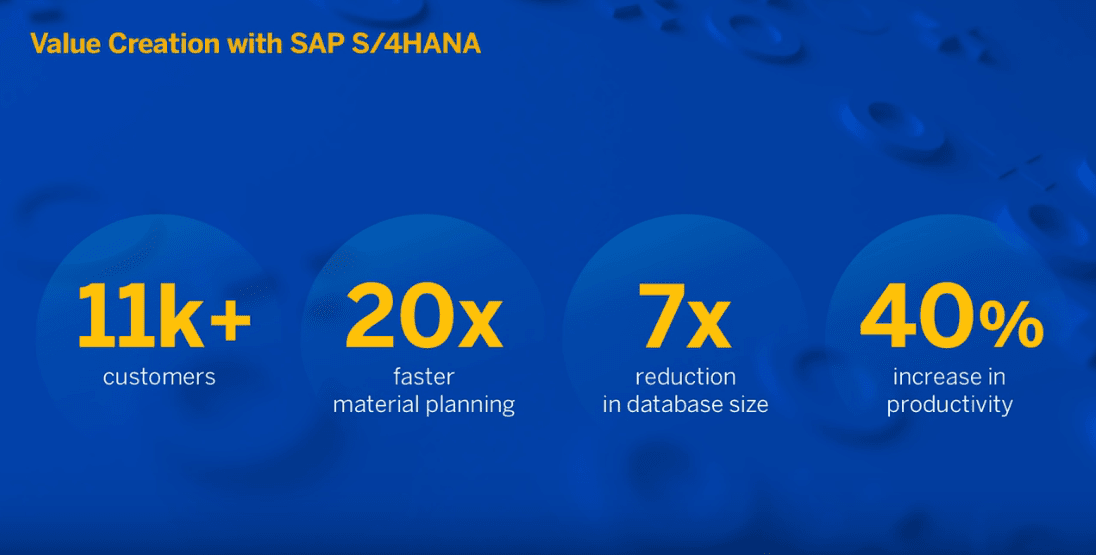How Accurate Was Hasso Plattner About SAP HANA Publications?
Executive Summary
- At SAPPHIRE 2019, Hasso Plattner makes claims around academic publications supporting HANA.
- We evaluate the accuracy of these claims by fact-checking the publications.

Introduction
This is the video of Hasso Plattner; we will be reviewing it for accuracy.
Our References for This Article
If you want to see our references for this article and other related Brightwork articles, see this link.
Notice of Lack of Financial Bias: We have no financial ties to SAP or any other entity mentioned in this article.
- This is published by a research entity, not some lowbrow entity that is part of the SAP ecosystem.
- Second, no one paid for this article to be written, and it is not pretending to inform you while being rigged to sell you software or consulting services. Unlike nearly every other article you will find from Google on this topic, it has had no input from any company's marketing or sales department. As you are reading this article, consider how rare this is. The vast majority of information on the Internet on SAP is provided by SAP, which is filled with false claims and sleazy consulting companies and SAP consultants who will tell any lie for personal benefit. Furthermore, SAP pays off all IT analysts -- who have the same concern for accuracy as SAP. Not one of these entities will disclose their pro-SAP financial bias to their readers.
The Hasso Plattner SAPPHIRE 2019 Video on Peer Reviewed Publications for HANA
Video removed from YouTube by SAP
SAP constantly removes old videos from YouTube. I believe they so often make false claims in the videos that they do not want a historical record. However, in the 2019 SAPPHIRE presentation, Hasso claimed that HANA’s claims were supported by articles published in peer-reviewed journals.
The 200+ Peer-Reviewed Articles on HANA?
This claim immediately struck me as odd. Every other claim in this slide is also not valid. But we will focus on the peer review claim.

We immediately suspected this claim because Hasso tends to lie all the time. Still, HANA is not a popular enough database, with many publications covering it as a topic.

Hasso quickly transitions to S/4HANA in the next slide. Each of these claims is wildly false.
- SAP report 11,000 customers, but these are license holders. S/4HANA has almost no real customers who live on S/4HANA. This may seem shocking. But once you move past the customers, which are SAP consulting companies that implemented the application for marketing reasons and used S/4HANA Cloud (which, in most cases, is not used by the consulting firm), validating any live S/4HANA customers becomes challenging. Virtually every S/4HANA implementation up to this point has failed.
- S/4HANA performs slower in material planning than ECC on Oracle, as we covered in the article HANA as a Mismatch for S/4HANA and ERP. Therefore 20x performance is impossible.
- HANA will reduce a previous production database supporting ECC by roughly 30 to 35%. This has come from many data points reported to us from the field, as we covered in Is Hasso Plattner and SAP Correct About Database Aggregates?
- SAP will not know if S/4HANA improves productivity because almost no one uses S/4HANA outside of test systems.
But the problem here, and it is a hugely significant problem, is that Hasso makes it sound as if these assertions are the conclusion of the 200+ peer-reviewed papers on HANA. If our contradiction is wrong, then the 200+ studies will clearly show that these are the average values where this extensive and peer-reviewed measurement of HANA benefits was performed. According to Hasso, the assertions of both slides are supported by these 200+ academic/peer-reviewed publications.
So do they? Let’s find out.
Our Analysis of the Peer-Reviewed Publications on HANA
The number of peer-reviewed publications can be found by using academic search engines. Using such engines will not capture all the articles in an area, but it will typically catch most of them. These were the publications that we could find. We evaluated them by where the authors worked and whether they supported the claims made by Hasso Plattner in his speech.
Publication #1: SAP HANA als Anwendungsplattform für Real-Time Business
- Author(s): This publication was written by P. Prassolb.
- Author Affiliation: P. Prassolb was employed by SAP at the time of this publication.
- Does the Paper Support Hasso’s SAPPHIRE Assertions?: No. Nowhere does the paper support any of the information published in the two slides in Hasso’s presentation.
- Can this be Counted as a Publications About HANA?: Yes
Publication #2: Managed Query Processing within the SAP HANA Database Platform
- Author(s): Normal May, A. Bohm, M. Block and W. Lehner
- Author Affiliation: P. the first three all worked for SAP at the time of publication. The employment of W. Lehner is unstated.
- Does the Paper Support Hasso’s SAPPHIRE Assertions?: No. The paper has nothing to do with measuring the benefits of HANA or S/4HANA.
- Can this be Counted as a Publications About HANA?: Yes
See the following quote from the publication.
“As a common abstraction layer for all these interfaces, we have defined the Core Data Services (CDS). In particular, the CDS is used for defining semantically rich domain data models which can be further enriched through annotations.”
This publication is not a research paper but a more detailed version of an SAP marketing document. There is no hypothesis proposed, and nothing has been tested. It is a listing of HANA’s technical offerings. It is unclear why this document was ever published in a journal.
Publication #3: Predictive Analytics in Marketing Mit Moderner Systemarchiteckture
- Author(s): This publication was written by Jan Matthes.
- Author Affiliation: Jan Matthes was employed by SAP at the time of publication.
- Does the Paper Support Hasso’s SAPPHIRE Assertions?: No. Nothing Hasso states in the SAPPHIRE presentation is even discussed in the paper.
- Can this be Counted as a Publications About HANA?: Yes
The paper’s synopsis includes the following description.
“This article addresses the in memory platform of SAP HANA. First it is being illustrated why SAP HANA is indeed a real platform. Subsequently, it is being explained to what extent SAP HANA can be seen as an innovative technology, what the differences to existing systems are and which opportunties are being offered to transform the technical capabilities of the platform into new business models and commerical success…the advantages of the in-memory technology compare to conventional disc-based databases are being examined. Furthermore column-based data storage, parallelization and the overcoming of the traditional separation of transactional and analytical data management are being discussed.”
These are all of the same claims made by SAP marketing, and they also do not appear to be research papers at all but are marketing documents that were somehow pushed through a peer-reviewed journal.
Publication #4: Evaluation of in-memory storage engine for machine learning analysis of security events
- Author(s): This publication was written by Andrey Sapegin, Marian Gawron, David Jaeger, Feng Cheng, and Christoph Meinel.
- Author Affiliation: Andrey Sapegin worked at SAP at the Hasso Plattner Institute at the publication time. The employment affiliation of the other authors is not listed. But a later paper #12 in this list contains all the authors (but one) as employed at the Hasso Plattner Institute.
- Does the Paper Support Hasso’s SAPPHIRE Assertions?: No. The entire focus of this paper is security. Therefore, it cannot be the source of Hasso Plattner’s information in his 2019 SAPPHIRE presentation.
- Can this be Counted as a Publications About HANA?: Yes
Publication #5: CancerLinQ Advancing Quickly
This is a one-page article in the Oncology Times and appears to be some promotional insert. The only reference to HANA is the following.
“…CancerLinQ LLC, now has teamed with the software manufacturer SAP to use the SAP HANA platform to develop CancerlinQ.”
It isn’t easy to understand how this is a peer-reviewed article.
- Can this be Counted as a Publications About HANA?: No
Publication #6: Design Thinking
- Author(s): This publication was written by Christoph Meinel and Julian von Thienen.
- Author Affiliation: Christoph Meinel and Julian von Thienen both work for the Hasso Plattner Institute.
- Does the Paper Support Hasso’s SAPPHIRE Assertions?: No. HANA is barely mentioned in the article, and the article is about Design Thinking.
- Can this be Counted as a Publications About HANA?: No
Publication #7: Big Data: Herausforderungen und Potenziale für deutsche Softwareunternehmen
- Author(s): This publication was written by Dr. Stephan Fischer
- Author Affiliation: Stephan Fischer worked at SAP at the time of the publication.
- Does the Paper Support Hasso’s SAPPHIRE Assertions?: No. Hasso’s claims are unrelated to Big Data.
- Can this be Counted as a Publications About HANA?: Yes
Publication #8: Graph Processing Using SAP HANA: A Teaching Case
- Author(s): This publication was written by Mark Hwang.
- Author Affiliation: Mark Hwang was employed at Central Michigan University at the time of publication.
- Does the Paper Support Hasso’s SAPPHIRE Assertions?: No. This paper has to do with using HANA as a graph database, which is 3+ years of researching HANA is the first time this topic has come up. It is not a paper that has anything to do with Hasso’s claims.
- Can this be Counted as a Publications About HANA?: Yes
The following quote is from this paper.
“The purpose of this teaching case is to develop a hands-on exercise on graph processing using a hybrid system. The paper provides a background on graph databases and how graph processing is supported in a hybrid system, SAP HANA. It also details step-by-step instructions on how to create, modify, and process a graph database using SAP HANA. The teaching case provides instructors with materials that can be readily implemented in classrooms.”
The paper contains false statements about HANA, which have been copied and pasted from SAP marketing.
“In recent years SAP developed its proprietary in-memory database known as SAP HANA, which underpins a technology platform that supports real-time enterprise transactional and analytical processing.”
Publication #9: An In-Memory Approach to Sentiment Analysis Based on SAP HANA
- Author(s): This publication was written by Karl Kurbel, Dawid Nowak, Florian Jätzold, and Pavlo Glushko.
- Author Affiliation: None of the authors worked for SAP at publication. Although they do thank Niraj Singh and Frank Finkbohner from SAP AG “for their support and assistance with this project.”
- Does the Paper Support Hasso’s SAPPHIRE Assertions?: No. This paper has to do with a sentiment algorithm for analyzing social media. It is not a paper that has anything to do with Hasso’s claims.
- Can this be Counted as a Publications About HANA?: Yes
Publication #10: Improving Business Intelligence Applications by Using New Generation of Web and Mobile Technologies
- Author(s): This publication was written by Mihaela-Laura IVAN.
- Author Affiliation: Mihaela-Laura IVAN was employed SAP at the time of the publication.
- Does the Paper Support Hasso’s SAPPHIRE Assertions?: No. This paper is focused on showcasing HANA’s features. It is not a paper that has anything to do with Hasso’s claims.
- Can this be Counted as a Publications About HANA?: Yes
This paper is also filled with SAP marketing claims.
“There are presented the many advantages of which the final user can benefit, such as: fast performance when querying a request, data modelled with the last database innovation of SAP, SAP HANA database, which brings the biggest feature which is in-memory processing. This in-memory computing of SAP HANA enables people to focus on innovation.In the third section are described two examples of web and mobile applications developed with these technologies.
SAP Fiori comes with modern design for a rediscovereduser experience. SAP Fiori user experience (UX) represents a personalized user experience formulti-devices, responsiveness interfaceand with deployment options.When combined with the power of the SAP HANA platform, SAP Fiori provides exclusive responsiveness. SAP Fiori UX is used for enterpriseappsacross the mostbusiness scenarios.”
The overall study is a marketing document made to look like a research paper.
Publication #11: Sap Hana And Its Performance Benefits
- Author(s): This publication was written by Timur Mirzoev.
- Author Affiliation: Timur Mirzoev is listed as both a professor at Georgia Southern University and a systems engineer at Lockeed Martin.
- Does the Paper Support Hasso’s SAPPHIRE Assertions?: No. This paper has to do with when HANA can have its in-memory capabilities leveraged. It is not a paper that has anything to do with Hasso’s claims.
- Can this be Counted as a Publications About HANA?: Yes
Publication #12: Towards a system for complex analysis of security events in large-scale networks
- Author(s): This publication was written by Andrey Sapegin, David Jaeger, Feng Cheng, and Christoph Meinel.
- Author Affiliation: This is nearly the same team of authors that wrote the 4rth paper on this list, and all of the authors worked for the Hasso Plattner Insitute at the time of this publication.
- Does the Paper Support Hasso’s SAPPHIRE Assertions?: No. As with the previous paper by these authors, this paper has to do with security. It is not a paper that has anything to do with Hasso’s claims.
- Can this be Counted as a Publications About HANA?: Yes
Conclusion
When Hasso Plattner made the statement about 200+ peer-reviewed publications, he was lying about both the number of publications about HANA and the content of those publications.
- There are not 200+ publications on HANA; there are perhaps ten. (publication #5 is not a research paper, but an insert and publication #6 is not related to HANA but to design thinking)
- Nothing in the HANA peer-reviewed publications supports anything that Hasso asserted in the SAPPHIRE 2019 presentation. Only around 1/2 of the publications even qualify as research.
- Seven of the ten papers that qualify as actually about HANA were published by authors who work for either SAP or the Hasso Plattner Institute. This means the independence is reduced as to who authored peer-reviewed papers on HANA. The results of any document written by an employee of SAP will naturally be positive. Furthermore, Hasso misrepresented the peer-reviewed articles that do exist (the ten) by saying that the Hasso Plattner Institute reviewed the papers published on HANA – clearly indicating that the publications were written by others unassociated with SAP. This would be like Brightwork Research & Analysis, saying that we reviewed 150 papers, which showed that they agreed with our views on subject XYZ when we wrote most of the articles we reference as “external articles,” reviewed our articles. This is the absolute upper bar of deception.
- And in addition to Hasso Plattner’s conclusions being entirely manufactured, it calls into question the Hasso Plattner Institute’s legitimacy. They don’t appear to understand that, for example, a published paper is supposed to include a hypothesis, not merely a listing of product features of an item that your employer would like to sell.
Hasso Wins Our Golden Pinnocchio Award

Hasso’s claims around his assertions supported by 200+ peer-reviewed publications are why the Golden Pinnochio Award was created. And he gets one here.
Hasso Plattner’s presentation is the continuation of a long-term pattern of attempting to cloak marketing around HANA and S/4HANA in academic research legitimacy. Hasso Plattner misrepresents his honorary doctorate as a “real” doctorate, as we covered in Does SAP’s Hasso Plattner Have a Ph.D.? He has a ceremonial title as a fake computer science professor at the Hasso Plattner Institute, an academic impossibility. He has no degrees in computer science, much less a Ph.D. in computer science. At SAPPHIRE 2019, Hasso graduated to referring to non-existent research, only exaggerating the number of peer-reviewed HANA papers by 190+. Not only do the ten existing documents not support his assertions at SAPPHIRE, but they are also not related to his assertions. This was done in an attempt to sell more HANA and S/4HANA.
All of this is thoroughly disreputable behavior. But also wholly unsurprising. None of Hasso Plattner’s numbers on any topic is reliable, and he is willing to make up any number he needs to try to prove a point.
SAP also encourages it and is ignored by nearly all SAP resources.
*Through the assistance of some people who reached out, more articles were added to the analysis than my initial search engine found.
A Resistance to Criticize Obvious Lies by SAP
Hasso Plattner’s statement was publicly and widely reported, yet even though it was utterly false, no entity following SAP reported it.
Why?
A Consistent Pattern of Lying
After many years of analyzing SAP as one of the few full-time SAP analysts, the amount of inaccurate information that comes from SAP is a consistent theme. And these lies are accepted by SAP proponents for apparent reasons. Actually, beyond acceptance, these lies are most often repeated.
Should SAP Be Immune from Charges of Lying
This does bring up the question of whether SAP should be considered immune from charges of lying.
- That is, SAP is in a special category of company.
- That giant company should never be held to what is true because being large means they have natural authority, and that authority should not be questioned.
- SAP is German. And German companies don’t lie.
That is, should we accept that SAP has the right to lie as much as it seems necessary to meet its objectives and should not be criticized?
Are Lies Part of Capitalism?
I bring up this question because, in a recent discussion with an SAP proponent, I was told that in a capitalist system, it should be expected that software vendors will exaggerate.
It has been proposed to me that lying is ok if it is within a capitalist system. It is unclear as to whether lying is considered a part of communism. According to some, we must accept lying to participate in capitalism. And it implies that lying is acceptable depending on a country’s economic system.
Conclusion
However, SAP exaggerates far more than other software vendors, and I have the evidence to prove this, which anyone can see at A Study into SAP’s Accuracy. This is the most comprehensive listing of SAP’s accuracy documented. When we ask SAP proponents to provide their research into SAP’s efficiency, they disappear.
I know quite a few software vendors that, while presenting their products in the best possible light, do not consistently lie about their products, like SAP. We rate them at the bottom of vendor accuracy in our Honest Vendor Ratings. And, of course, all of these software vendors also operate within a capitalist system. But this research tells a different story of SAP’s lying. It illustrates that SAP’s lie is out of line with other vendors’ lying in scale and scope. This should not be seen as a blanket endorsement of different vendors, so we created the ratings for a reasonable number of vendors and rated each individually. This research, both in the accuracy of other vendors and a great deal of detail into SAP, allows us to say that SAP lies far higher than most software vendors.